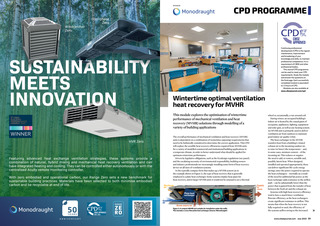


SPONSOR CPD PROGRAMME Continuing professional development (CPD) is the regular maintenance, improvement and broadening of your knowledge and skills, to maintain professional competence. It is a requirement of CIBSE and other professional bodies. This Journal CPD programme can be used to meet your CPD requirements. Study the module and answer the questions on the final page. Each successfully completed module is equivalent to 1.5 hours of CPD. Modules are also available at www.cibsejournal.com/cpd Wintertime optimal ventilation heat recovery for MVHR This module explores the optimisation of wintertime performance of mechanical ventilation and heat recovery (MVHR) solutions through modelling of a variety of building applications The overall performance of mechanical ventilation and heat recovery (MVHR) units is dependent on a combination of (sometimes opposing) requirements that need to be holistically considered to determine the correct application. This CPD will explore the sensible heat recovery efficiencies required from MVHR units for a variety of modelled commercial and institutional building applications in a temperate climate, in order to better understand what should be applied for optimum wintertime performance. Driven by legislative obligations, such as the Ecodesign regulations (see panel), and the escalating necessity of environmental responsibility, building owners and industry professionals are increasingly installing some form of heat recovery device on all sizes of ventilation systems. In the typically compact form that makes up a MVHR system (as in the example shown in Figure 1), the type of heat recovery that is generally employed is a plate heat exchanger. Some systems employ heat pipes for heat recovery, and in larger MVHR units it would not be unusual to see a thermal Discharge air Supply to room Plate heat exchanger Outdoor air Fan Room return air Figure 1: A compact MVHR unit suitable for installation under the soffit. This includes a cross-flow plate heat exchanger (Source: Monodraught) Filter wheel or, occasionally, a run-around coil. During winter, an occupied buildings indoor air is heated by the casual gains of occupants, appliances, lighting, equipment and solar gain, as well as any heating system. An MVHR unit is primarily used to deliver ventilation air from outdoors to maintain good indoor air quality (IAQ). The heat exchanger in the MVHR transfers heat from a buildings vitiated exhaust air to the incoming outdoor air, to raise (or lower) the temperature and, in some cases, moisture content of the incoming air. This reduces or negates the need to add, or remove, sensible and, possibly, latent heat. When designed, installed and operated appropriately, these can deliver significant life-cycle energy savings, since the power required to operate the heat exchangers normally as a result of the need for additional fan power, as the heat exchanger adds resistance to the airflow path can be substantially lower than the power that is gained from the transfer of heat between the fresh air and the exhaust air. Systems with high heat recovery efficiency tend to have a much lower ventilation flowrate efficiency, as the heat exchangers create significant resistance to airflow. This means that when the heat recovery is not fully required or used, the efficiency of the systems suffers owing to the increased www.cibsejournal.com July 2023 51